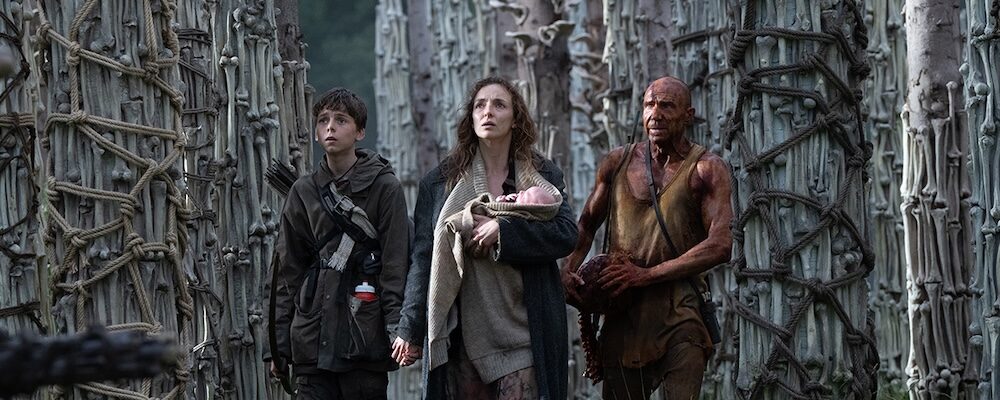‘28 Years Later’: Danny Boyle Revives His Post-Apocalyptic World With Unchained Ferocity
Alci Rengifo
The world is going crazy. As liberties erode and missiles streak across skies, we don’t know who we can trust. The terrain is ripe for Danny Boyle’s “28 Years Later,” a sequel that also works as a general franchise revival. It has been 23 years since Boyle released “28 Days Later,” a gritty, apocalyptic horror thriller that left its mark. By setting the story decades after the original (and its efficient sequel, 2007’s “28 Weeks Later,” directed by Juan Carlos Fresnadillo), Boyle and writer Alex Garland, who penned the original, have the freedom to essentially reimagine their premise. With confidence they deliver something quite bloody and wild.
The opening informs us that the ultra-contagious Rage virus has been driven off mainland Europe, leaving the U.K. as an isolated, quarantined island. Its inhabitants live cut off from the modern world, left to fend for themselves against the dangerous Infected. On Holy Island, just off the coast of Northern England, Jamie (Aaron Taylor-Johnson) and his 12-year-old son, Spike (Alfie Williams) live in a collective behind guarded walls, using bows and arrows for defense. While crossing the causeway that during low tide leads to the mainland, father and son encounter the latest variant of these infected, bloated attackers who eat earth worms. They also spot another form of infected who show the ability to be more intelligent and dangerous, the “Alphas.” At home, Spike’s mother, Isla (Jodie Comer), suffers from an unknown illness. Could it be a mutation of the Rage virus? Determined to get answers, Spike and Isla defy Jamie and cross back to the mainland.
Though Boyle refuses to call his saga a zombie franchise, the original “28 Days Later” has been credited with revitalizing the genre. It was a horror film with an almost punk spirit in its digital aesthetic, frenetic editing and use of rock and pop music. The opening scenes of a disoriented Cillian Murphy wandering an abandoned London have a lasting power made even more relevant in our post-pandemic world. Boyle and Garland return to their creation having both grown as filmmakers. Boyle has a Best Picture Oscar under his belt for “Slumdog Millionaire” and Garland is renowned for his hallucinatory films, like “Ex Machina” and “Annihilation.” As a result, “28 Years Later” is a broader work of dystopia, packing gore and horror with rich subtext and moments that are genuinely moving, even as they verge on nightmare surrealism.
Visually this marks a return to the experimental spirit of the original while raising the volume. Cinematographer Anthony Dod Mantle shoots on cutting-edge iPhones, achieving a stunning widescreen canvas that can also get jagged. Shots of Jamie and Spike escaping from an Infected below a starry night have a certain beauty, they then contrast with up close editing of attacks where flesh gets chewed and heads ripped off bodies, spinal cords dangling. In the first passages of this movie the editing by Jon Harris takes on a feverish quality similar to early Oliver Stone films, inserting stock footage from classic films and news clips in-between moments of action or contemplation, as when Jamie trains Spike in archery. It all comes together to imagine an England thrown back into primitive living. Forests are dangerous terrains where the infected or other threats, like foreign troops, can suddenly appear.
In the tradition of George A. Romero, Boyle and Garland again utilize the premise for deeper meaning. It is easy to see allegories in “28 Years Later” to contemporary issues in the U.K., where Brexit left the country nearly isolated, and concerns of immigrants or perceived outside threats have sparked a rise in right-wing nationalism. Covid and pandemic fears of mass deaths are also hiding in the margins of this screenplay. One of the most memorable characters is Dr. Kelson (Ralph Fiennes), a doctor living like a slowly maddening survivalist, smeared in iodine because it keeps the virus at bay. He appears early on, seeming to burn corpses in large bonfires. He does indeed collect the skulls of the dead, as a way to remember those who perish while reminding passersby of mortality. Themes of empathy are included in how Kelson doesn’t kill the infected. He merely knocks them out with a sedative in order to escape. The carriers of the Rage virus are still human in a way, only damned to a cruel fate.
“28 Years Later” has great moments of genuine horror, the kind that will rattle sensitive viewers. Yet, it is a great genre film by having the structure and craft of good filmmaking. Bittersweet moments involving Spike and Isla brim with empathy. This movie doesn’t feel like another cynical cash grab banking off franchise recognition. Boyle has reportedly planned a trilogy, with the second film, “The Bone Temple,” already slated for release next year. He certainly ends this one with enough plot to spare, including a new character named Jimmy (Jack O’Connell), who leads a pack of zombie killers with colored attire inspired by a particular children’s show from the early days of the millennium. The score by Young Fathers ranges from thundering rock to eerie atmospherics. By being allowed to run free, the makers of “28 Years Later” keep us excited for the next showdown with its rotting, terrifying menaces.
“28 Years Later” releases June 20 in theaters nationwide.

